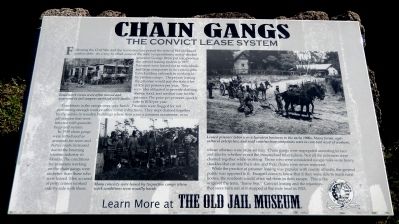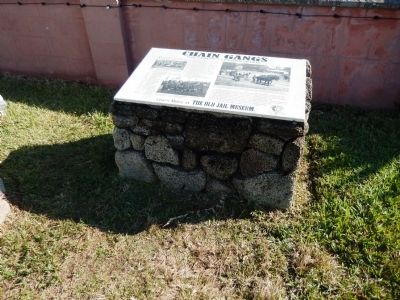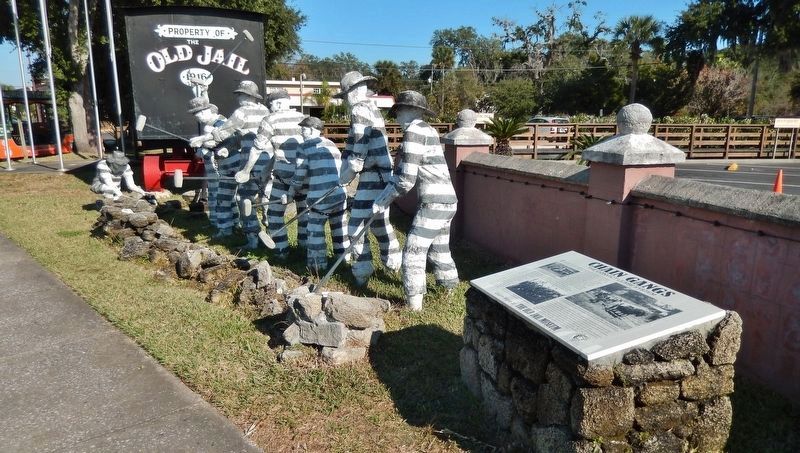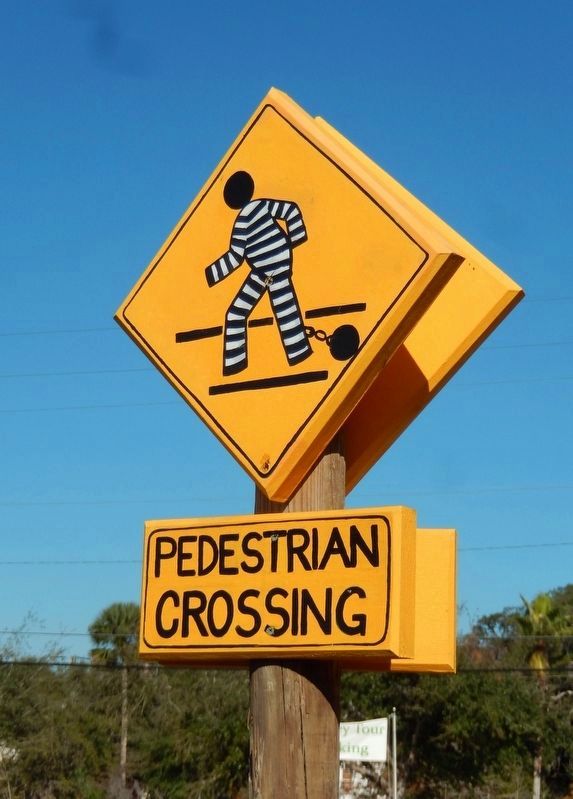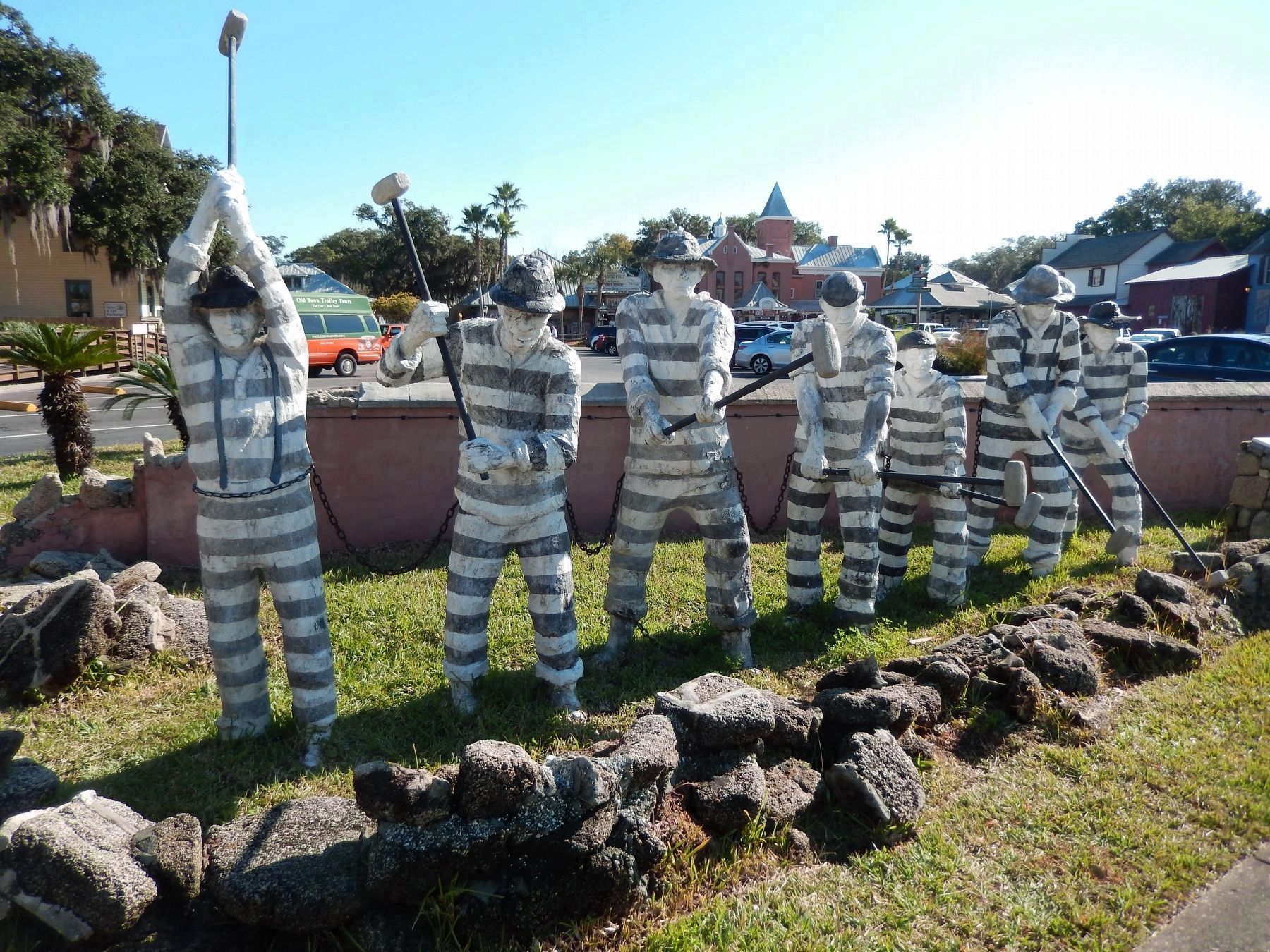Historic District in St. Augustine in St. Johns County, Florida — The American South (South Atlantic)
Chain Gangs
The Convict Lease System
Conditions in the camps were very harsh. Prisoners were flogged for not performing enough work or other minor infractions. They slept chained together by the ankles in wooden buildings where fires were a common occurrence, or in jail wagons that were infested with parasitic bugs and vermin.
In 1919 chain gangs were introduced as demands for more and better roads increased due to the booming tourism industry in Florida. The conditions for prisoners working on the chain gangs were no better than those who were leased. Men accused of petty crimes worked side by side with those whose offenses were more serious. Chain gangs were segregated according to race and also by whether or not the inmates had tuberculosis. Not all the prisoners were chained together while working. Those who were considered escape risks wore heavy shackles that cut into their skin and their chains were never removed.
While the practice of prisoner leasing was popular with county officials, the general public was opposed to it. Escaped convicts knew that if they were able to reach rural homes, the residents would often aid them in their escape. This is the origin of the term, “home free.” Convict leasing and the injustices that were born out of it stopped at the state level in 1923.
Captions:
(upper left) Road work crews were often moved and quarterd in jail wagons outfitted with bunks.
(lower left) Many convicts were leased by turpentine camps where work conditions were usually harsh.
(upper right) Leased prisoner labor was a lucrative business in the early 1900s. Many farms, agricultural enterprises, and road construction companies were in constant need of workers.
Erected by The Old Jail Museum.
Topics. This historical marker is listed in these topic lists: Civil Rights • Government & Politics • Law Enforcement • Roads & Vehicles. A significant historical year for this entry is 1877.
Location. 29° 54.494′ N, 81° 19.179′ W. Marker is in St. Augustine, Florida, in St. Johns County. It is in the Historic District. Marker is at the intersection of San Marco Avenue (Business U.S. 1) and Missouri Avenue, on the left when traveling south on San Marco Avenue. Marker is located in front of the Old Jail Museum complex. Touch for map. Marker is at or near this postal address: 167 San Marco Avenue, Saint Augustine FL 32084, United States of America. Touch for directions.
Other nearby markers. At least 8 other markers are within walking distance of this marker. Jail on Wheels (a few steps from this marker); Henry Flagler's "Winter Newport" (a few steps from this marker); Slaves No More (a few steps from this marker); On With The Show (a few steps from this marker); Viva Cuba! (within shouting distance of this marker); Up in Smoke (within shouting distance of this marker); Arriving in Style (within shouting distance of this marker); Walk to Freedom (within shouting distance of this marker). Touch for a list and map of all markers in St. Augustine.
Also see . . .
1. Chain Gang (Wikipedia). The introduction of chain gangs into the United States began shortly after the American Civil War. The southern states needed finances and public works to be performed. Prisoners were a free way for these works to be achieved. Florida's chain gangs were introduced in 1919 partly because an increasing number of roads were needed to keep pace with the growing number of tourists to Florida. (Submitted on December 10, 2014, by Cosmos Mariner of Cape Canaveral, Florida.)
2. Cool Hand Luke (Internet Movie Database). It's been said that if Donn Pearce is remembered at all, it won't be for having written "Cool Hand Luke," his acclaimed but little-read novel about his life as a convict on a southern chain gang, but for the classic movie based on it. Starring Paul Newman in the Oscar-nominated title role, Cool Hand Luke (1967) was both a critical and commercial success. An outstanding film across the board, it brought us one of the screen's most compelling anti-heroes and one of the all-time great movie lines: "What we've got here is failure to communicate." (Submitted on April 21, 2019, by Cosmos Mariner of Cape Canaveral, Florida.)
Credits. This page was last revised on April 22, 2019. It was originally submitted on December 10, 2014, by Cosmos Mariner of Cape Canaveral, Florida. This page has been viewed 934 times since then and 35 times this year. Photos: 1, 2. submitted on December 10, 2014, by Cosmos Mariner of Cape Canaveral, Florida. 3, 4, 5. submitted on April 21, 2019, by Cosmos Mariner of Cape Canaveral, Florida. • Bernard Fisher was the editor who published this page.
